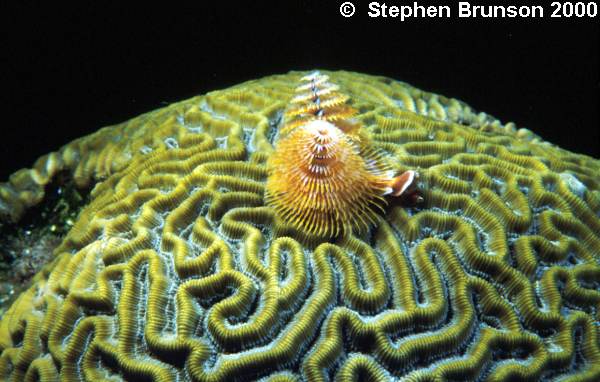








Sea Anemones and Corals
I photographed this picture in Roatan, which is part of the second largest great barrier reef in the world. This is a christmas tree coral on a massive brain coral, shot at approximately 1:2 macro.

Print Number - AC017
Limited Edition signed color photography for sale by Stephen Brunson
Coral Statistics:
Coral is the common name for a large group of marine invertebrates of the class Anthozoa, which also includes sea anemones, in the phylum Coelenterata.
Anthozoan corals are characterized by a protective calcium carbonate or horny skeleton, also called coral. They are divided into two subclasses, based on differences in their radial symmetry. The subclass Octocorallia or Alcyonaria consists of colonial, eight-tentacled animals, each with an internal skeleton. Among them are whip corals, gorgonians, and the red coral used in making jewelry. Members of the other subclass, Zoantharia, or Hexacorallia, commonly have six tentacles, or multiples of six, but
other patterns are also observed. They included the stony, or true, corals, order Scleractinia or Madreporaria. Living polyps build on the deposits of their predecessors; the wide range of branched or massive forms that results depends on the species involved.
True corals secrete calcium carbonate from the bottom half of the stalk of the individual animal, or polyp, forming skeletal cups to which the polyps are anchored and into which they withdraw for protection. In the flattened oral disc at the top of the stalk is an opening, edged with feathery tentacles and cilia, that is both mouth and anus. At night the tentacles extend from the cup, seize animal plankton that wash against them, and carry the food to the mouth. Stinging cells, or nematocysts, on the tentacles can also paralyze prey.
Some scleractinians exist as solitary polyps, such as Fungia of the Indian and
Pacific oceans, but the majority are colonial. Most colonial polyps average from 1 to 3mm in diameter. They are connected laterally by tubes that are simply an extension of the polyps' gastrovascular cavities, and the colony grows by asexual budding from the base or the oral disc of the polyps.
BrunsonImages@att.net


















